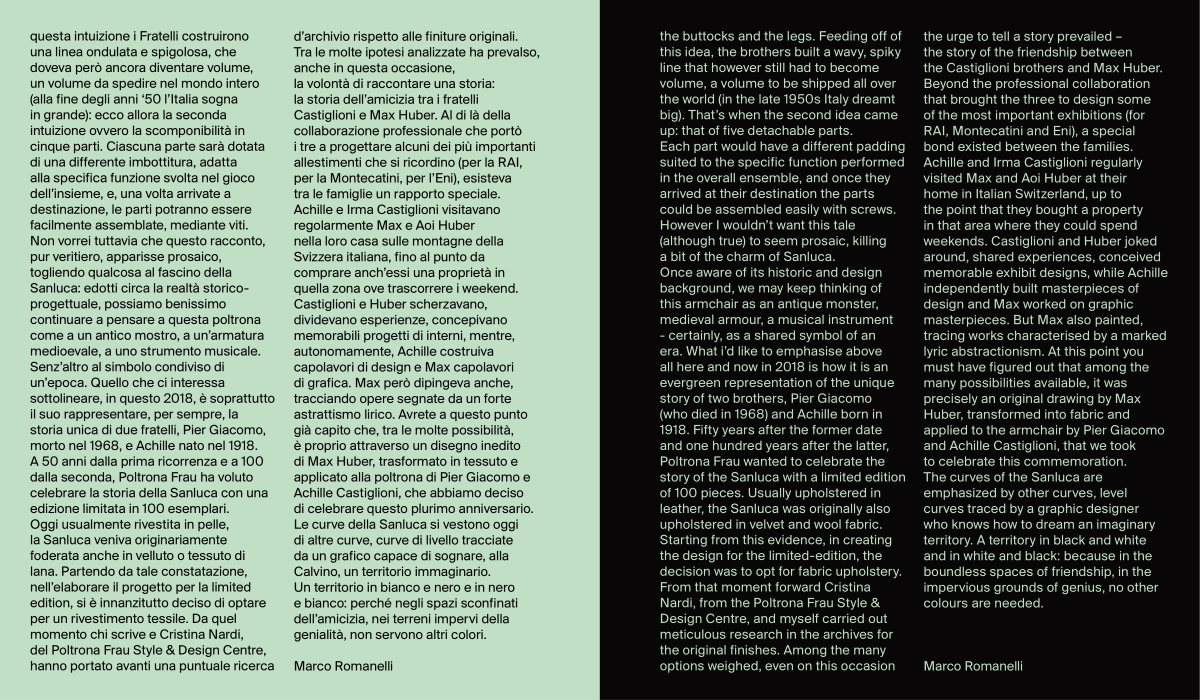questa intuizione i Fratelli costruirono
una linea ondulata e spigolosa, che
doveva però ancora diventare volume,
un volume da spedire nel mondo intero
(alla fine degli anni ‘50 l’Italia sogna
in grande): ecco allora la seconda
intuizione ovvero la scomponibilità in
cinque parti. Ciascuna parte sarà dotata
di una differente imbottitura, adatta
alla specifica funzione svolta nel gioco
dell’insieme, e, una volta arrivate a
destinazione, le parti potranno essere
facilmente assemblate, mediante viti.
Non vorrei tuttavia che questo racconto,
pur veritiero, apparisse prosaico,
togliendo qualcosa al fascino della
Sanluca: edotti circa la realtà storico-
progettuale, possiamo benissimo
continuare a pensare a questa poltrona
come a un antico mostro, a un’armatura
medioevale, a uno strumento musicale.
Senz’altro al simbolo condiviso di
un’epoca. Quello che ci interessa
sottolineare, in questo 2018, è soprattutto
il suo rappresentare, per sempre, la
storia unica di due fratelli, Pier Giacomo,
morto nel 1968, e Achille nato nel 1918.
A 50 anni dalla prima ricorrenza e a 100
dalla seconda, Poltrona Frau ha voluto
celebrare la storia della Sanluca con una
edizione limitata in 100 esemplari.
Oggi usualmente rivestita in pelle,
la Sanluca veniva originariamente
foderata anche in velluto o tessuto di
lana. Partendo da tale constatazione,
nell’elaborare il progetto per la limited
edition, si è innanzitutto deciso di optare
per un rivestimento tessile. Da quel
momento chi scrive e Cristina Nardi,
del Poltrona Frau Style & Design Centre,
hanno portato avanti una puntuale ricerca
d’archivio rispetto alle finiture originali.
Tra le molte ipotesi analizzate ha prevalso,
anche in questa occasione,
la volontà di raccontare una storia:
la storia dell’amicizia tra i fratelli
Castiglioni e Max Huber. Al di là della
collaborazione professionale che portò
i tre a progettare alcuni dei più importanti
allestimenti che si ricordino (per la RAI,
per la Montecatini, per l’Eni), esisteva
tra le famiglie un rapporto speciale.
Achille e Irma Castiglioni visitavano
regolarmente Max e Aoi Huber
nella loro casa sulle montagne della
Svizzera italiana, fino al punto da
comprare anch’essi una proprietà in
quella zona ove trascorrere i weekend.
Castiglioni e Huber scherzavano,
dividevano esperienze, concepivano
memorabili progetti di interni, mentre,
autonomamente, Achille costruiva
capolavori di design e Max capolavori
di grafica. Max però dipingeva anche,
tracciando opere segnate da un forte
astrattismo lirico. Avrete a questo punto
già capito che, tra le molte possibilità,
è proprio attraverso un disegno inedito
di Max Huber, trasformato in tessuto e
applicato alla poltrona di Pier Giacomo e
Achille Castiglioni, che abbiamo deciso
di celebrare questo plurimo anniversario.
Le curve della Sanluca si vestono oggi
di altre curve, curve di livello tracciate
da un grafico capace di sognare, alla
Calvino, un territorio immaginario.
Un territorio in bianco e nero e in nero
e bianco: perché negli spazi sconfinati
dell’amicizia, nei terreni impervi della
genialità, non servono altri colori.
Marco Romanelli
the buttocks and the legs. Feeding off of
this idea, the brothers built a wavy, spiky
line that however still had to become
volume, a volume to be shipped all over
the world (in the late 1950s Italy dreamt
big). That’s when the second idea came
up: that of five detachable parts.
Each part would have a different padding
suited to the specific function performed
in the overall ensemble, and once they
arrived at their destination the parts
could be assembled easily with screws.
However I wouldn’t want this tale
(although true) to seem prosaic, killing
a bit of the charm of Sanluca.
Once aware of its historic and design
background, we may keep thinking of
this armchair as an antique monster,
medieval armour, a musical instrument
- certainly, as a shared symbol of an
era. What i’d like to emphasise above
all here and now in 2018 is how it is an
evergreen representation of the unique
story of two brothers, Pier Giacomo
(who died in 1968) and Achille born in
1918. Fifty years after the former date
and one hundred years after the latter,
Poltrona Frau wanted to celebrate the
story of the Sanluca with a limited edition
of 100 pieces. Usually upholstered in
leather, the Sanluca was originally also
upholstered in velvet and wool fabric.
Starting from this evidence, in creating
the design for the limited-edition, the
decision was to opt for fabric upholstery.
From that moment forward Cristina
Nardi, from the Poltrona Frau Style &
Design Centre, and myself carried out
meticulous research in the archives for
the original finishes. Among the many
options weighed, even on this occasion
the urge to tell a story prevailed –
the story of the friendship between
the Castiglioni brothers and Max Huber.
Beyond the professional collaboration
that brought the three to design some
of the most important exhibitions (for
RAI, Montecatini and Eni), a special
bond existed between the families.
Achille and Irma Castiglioni regularly
visited Max and Aoi Huber at their
home in Italian Switzerland, up to
the point that they bought a property
in that area where they could spend
weekends. Castiglioni and Huber joked
around, shared experiences, conceived
memorable exhibit designs, while Achille
independently built masterpieces of
design and Max worked on graphic
masterpieces. But Max also painted,
tracing works characterised by a marked
lyric abstractionism. At this point you
must have figured out that among the
many possibilities available, it was
precisely an original drawing by Max
Huber, transformed into fabric and
applied to the armchair by Pier Giacomo
and Achille Castiglioni, that we took
to celebrate this commemoration.
The curves of the Sanluca are
emphasized by other curves, level
curves traced by a graphic designer
who knows how to dream an imaginary
territory. A territory in black and white
and in white and black: because in the
boundless spaces of friendship, in the
impervious grounds of genius, no other
colours are needed.
Marco Romanelli
9


